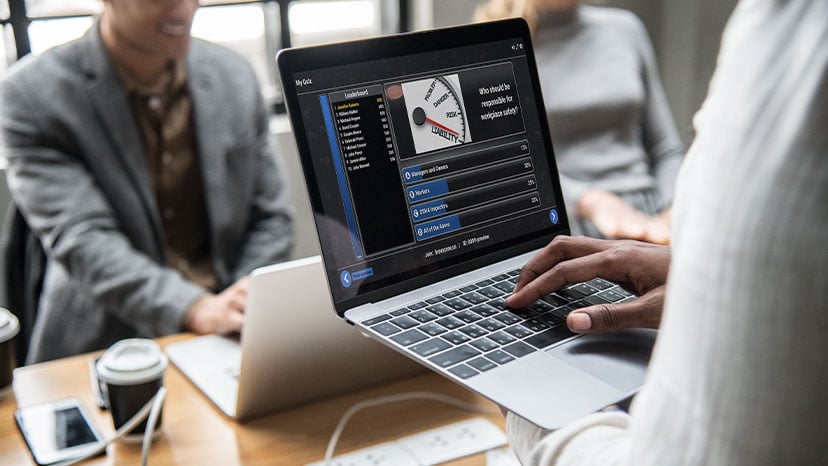


Guest Blog from C3 SoftWorks - Written By: Erin Patrick-Proza
Are you tired of getting the same reactions to your formalized training? Do you want to get better participation in your learning and development program with observable results that last? In this blog, we will be talking about adaptive content learning and delivery, and how gamification is a key component for achieving better outcomes that help create a culture of learning.
This is a concept that exists in both learning and marketing, and the goal is to deliver personalized content that can be accessed over multiple channels and technologies. It’s responsive and adaptive, and it meets your learners where they are, meaning it’s mobile and highly accessible. In the context of serious learning, we’re aiming to create an experience of learning that is comprehensive and engaging and goes beyond the robotic response to mandatory learning. When we create a culture of learning, we offer an environment where the participants can own their learning process, motivated by the golden standard of intrinsic motivation. Daniel Pink explores this idea in his book published in 2009 called Drive: The Surprising Truth About What Motivates Us and examines how the business world might have a large disconnect in how it interprets incentives through many cross-cultural studies. His theory aligns with Herzberg’s Two Factor Theory which states that money or any other external motivators are not effective. In Daniel Pink’s TED Talk: The puzzle of motivation (TEDGlobal, 2009), he says that how we typically apply our human resources with these “contingent motivators” is wrong and outdated and this might cause the opposite effect on achievement, especially for any kind of cognitive learning or complex task completion. His solution is to instead offer three elements that construct human drivers of motivation: autonomy, mastery, and purpose. He expands on autonomy as a model of management with self-direction as the goal, where people have the freedom to access their creativity, level up their knowledge, and find purpose in what they do. He states,
“The secret to high performance isn’t rewards and punishments, but that unseen intrinsic drive- the drive to do things for their own sake. The drive to do things because they matter.”
The adaptive content addresses the type of information needing to be learned, and gamification helps increase engagement with that content. What gamification also provides is the chance for learners to apply their knowledge, and gain mastery in a fun way. This does require some intentional thinking around what, how, and when this learning takes place to find the sweet spot of quality content that learners can access on-demand, as well as engaging elements to keep them wanting to participate. Enter gamification.

Adaptive content delivery strives to offer the learner a way to gain proficiency in a flexible but effective way that is also observable. When combined with gamification, it’s paving a path for learners to be the navigator of their progression and masters of their learning universe. The content can be designed to respond to the needs of the learner and gamification helps provide feedback for more teachable moments, thus enabling a feedback loop for both the learner and the instructor to know what they know in real-time and remediate as necessary. The learner is also maximizing knowledge retention rates through experiential learning that combines the concept of Microlearning with spaced retrieval, and according to the eLearning Industry, this is “when learners are required to recall or apply the information that they have learned through interesting gamification and moving that information from short-term to long-term memory, which is what knowledge retention is all about.”
Play the C3 SoftWorks SpringTime Trivia Game (created with WHIRL) and imagine how engaging your content could be, delivered through any of the eight game templates that make up the BravoZone.
Gamification also establishes learning that is both meaningful and fun, and a little can go a long way toward increasing the engagement and participation factor. For instance, you might offer incremental games or quizzes that both reinforce knowledge, introduce new content, and can be finished in under 5 minutes, allowing employees to access these modules as a fun activity and complete them on the go during their shifts. Or, perhaps you have a specific workflow or infographic that you can gamify the steps (to that process) for a quick learning opportunity. This speaks to the microlearning approach that offers nuggets of learning over spaced intervals and boosts retention of knowledge. It also provides them the autonomy to learn at their own pace, in a unique and personalized way.
Gamified microlearning also helps avoid the forgetting curve in learning and development and aligns with the 70/20/10 learning model, which asserts that
When people can apply their knowledge, problem solve, and receive feedback while they play an interactive game- either in a classroom, webinar, or eLearning- they are now part of an immersive experience that allows them to be autonomous, master their skills, and find meaning and purpose in their development. Happy employees are more productive, efficient, and more likely to communicate creative solutions, which contributes to a healthier workforce and bottom lines. This may sound very utopian, but according to Steve Jobs, the people who are crazy enough to think they can change the world are the ones that do.
Review time! Try this self-paced quiz to test your knowledge of adaptive content delivery and learning and experience microlearning + gamification!
Integrating games into your learning program is great for many leadership skills as well: soft skill development, professional development, or your general compliance or review content, based on its ability to be participant-centered. It can also be used situationally and scaled for scenario training, such as sales or product knowledge. It’s designed to be short and sweet for multi-media consumption, so it can be easily accessible with devices such as phones and tablets, which keeps people mobile and flexible for on-demand learning. This allows the focus to be on performance gains with valuable feedback and creating quality content that people love, all while using games to deliver your information to an informal and safe learning environment. And, by turning your content into fun, engaging, and interactive sessions you can pull all learning styles into the fold, no matter the subject matter. All of this can help prompt positive changes in behavior and engagement. But don’t take our word for it:
"Works like a dream! Your product has enabled us to keep providing essential training thru this pandemic and allowed us to do things that we never expected to need at the start of 2020. Thank you."
-Fred Bause (Vestas Blades America)
At C3 SoftWorks, we’re passionate about helping people find unique solutions to their training and education goals and have over 35 years of experience in those fields. We strive to make gamification easy and our single but powerful platform can deliver many ways to make your training more engaging. If you’d like some ideas on navigating a hybrid learning environment using games, we’re here to help.
Don't miss out on updates and chances
to sharpen your skills with participant-centered learning.




3740 N Chestnut St #113 - Chaska, MN 55318-3053